Saint Lucia – the small tropical pearl of the Caribbean. While many vacationers only take a day trip and then stroll back to the cruise ship, it is also worthwhile to explore the island on your own for several days. Saint Lucia in the Caribbean has an incredible amount to offer and is perfect for a 10 or even 14-day vacation.
The lush green hills, the stunningly beautiful beaches, the numerous attractions and exceptional accommodations, the Caribbean food, the friendly people and the culture make Saint Lucia one of the top destinations in the Caribbean. We were able to explore the island together with the Saint Lucia Tourism Authority and have brought home the most important information, many Saint Lucia tips and great highlights for you.
- 1. Saint Lucia in the Caribbean
- 2. Arrival in Saint Lucia
- 3. Entry and Airport
- 4. Best time to travel to Saint Lucia
- 5. Currency and finances
- 6. Vaccinations and health
- 7. Accommodation on the island
- 8. Local transport
- 9. Booking a rental car and getting a driver’s license
- 10. Road conditions and rules
- 11. Safety on Saint Lucia
- 12. Budget and costs
- 13. Food and drink
- 14. Things to do in Saint Lucia
- 15. Beaches on Saint Lucia
- 16. Packing list for your vacation
- Conclusion on Saint Lucia
1. Saint Lucia in the Caribbean
Saint Lucia is located in the Caribbean and is part of the Lesser Antilles. The small island lies just 33 kilometers south of Martinique, and Barbados is only about 146 kilometers away as the crow flies. Many other islands, such as Antigua, St. Kitts, Guadeloupe, Dominica, St. Vincent, Grenada, and Nevis, are also located in this region.
It’s no wonder, then, that many vacationers travel by cruise ship and opt for island hopping. A look at the population statistics for St. Lucia clearly shows that the island’s population has more than doubled since 1950. Today, around 166,000 people live on Saint Lucia. By comparison, around 160,000 people live in Heidelberg alone.
The island is not particularly large. From north to south, it is 44 kilometers and from west to east just 22 kilometers. The capital and largest city in the country is Castries. Including the suburban area, around 66,000 people live here alone.
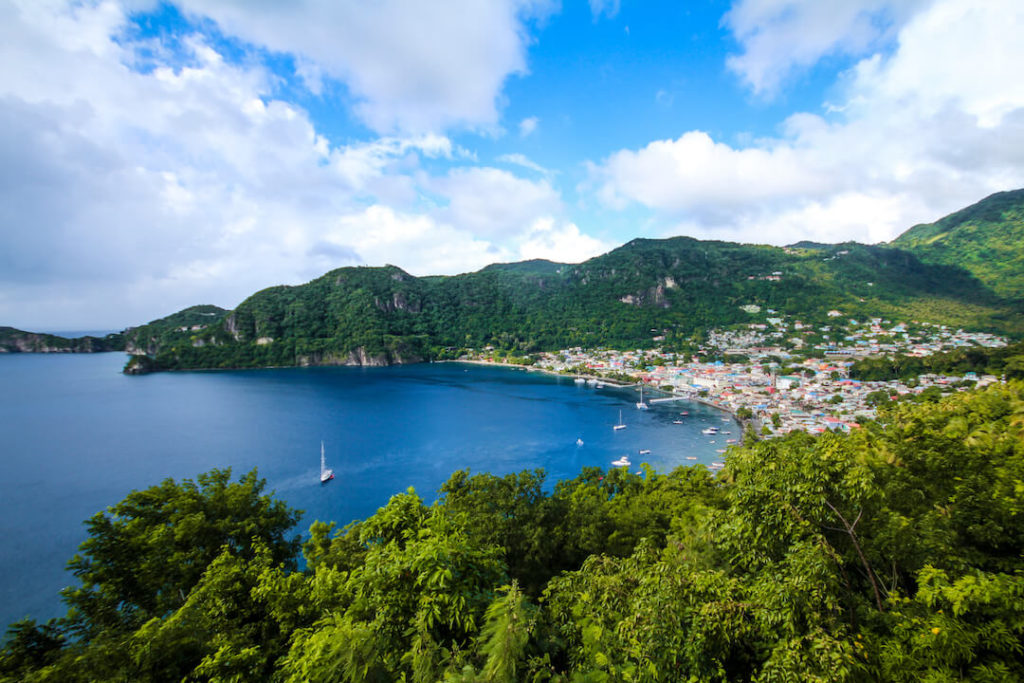
On Saint Lucia, English and Antillean Creole (Kwéyòl or Patois) are primarily spoken. 67.5% of the population belong to the Catholic Church. The island’s history is also very interesting: In total, the island has changed hands 14 times. After all the disputes between the United Kingdom and France, the Kingdom ultimately claimed the island in 1814 through the resolution of the Congress of Vienna. What a back and forth, right?
2. Getting to Saint Lucia
It could be so easy! There used to be a direct connection from Frankfurt to Saint Lucia with Condor. Unfortunately, this has been discontinued. Currently, the following options are available: You can fly from Germany to Manchester and from there take a direct flight to the island every Thursday with Thomas Cook/Condor. This connection is available every Thursday from Frankfurt and Munich between November 8, 2018 and March 14, 2019. The total flight time from Frankfurt is approximately 9.5 hours.
Update 05/2020: Unfortunately, Thomas Cook no longer exists, nor does the connection from Manchester.
With Air France you can fly to Martinique via Paris and from there continue to Saint Lucia by plane or ferry. British Airways flies to the island all year round via London Gatwick. There are also flights to Saint Lucia via Frankfurt and Toronto with Air Canada. In general, you should expect to pay at least €700-€1000 for flights (and more) and one or two layovers.
There are two airports on the island: the international airport in the southeast of the island and the smaller airport in Castries, which serves domestic Caribbean flights. The time difference to Germany is -5 hours in winter and -6 hours in summer.
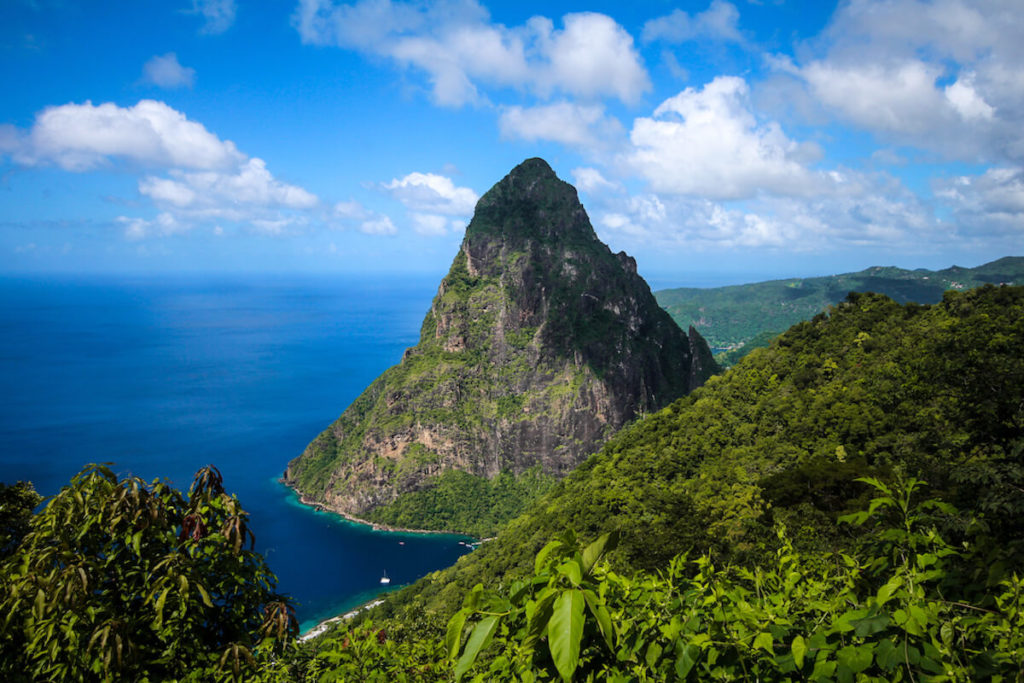
It should be noted that the connection to Saint Lucia is not ideal. On the way there, we first had to take the bus to Hamburg and then on to Manchester. We spent one night there before continuing on to Saint Lucia the next morning. If you can depart from Frankfurt or Munich, you’ll save some time, as you won’t have to spend the night in Manchester. It all depends on how early you can depart from Germany to Manchester.
The return journey to Rostock took us more than 24 hours. What we didn’t know at first: The plane from Manchester continues on to Barbados after landing in Saint Lucia. So, on the way back, we had to get off in Barbados and wait two hours. This is where the plane is cleaned and refueled for the return flight to Manchester.
3. Entry and Airport
You will land at Hewanorra International Airport in the southeast of the island. The airport itself has a few shops and fast-food restaurants. Wi-Fi is also available. You do not need to apply for a visa in advance to enter Saint Lucia. At the airport, you can obtain a residence permit for up to 90 days with a valid passport. However, you should have an onward or return ticket (Source: Federal Foreign Office).
Before landing on the plane, you will also receive an entry document, which you must fill out. You should store your exit document safely and have it handy for your return journey. If you are entering or exiting via the USA, be sure to check the Federal Foreign Office website. By the way: From the airport, it took us almost two hours by taxi to Gros Islet in the north, without much traffic. The trip cost us around €100.
4. Best time to visit Saint Lucia
There are two seasons on the island: the rainy season and the dry season. You can find information online that you should avoid the hurricane season between June and November. However, we were told locally that the months to go are more likely to be July, August, and September. The tourist peak season is primarily between December and March. However, you can expect higher prices and many more tourists then.
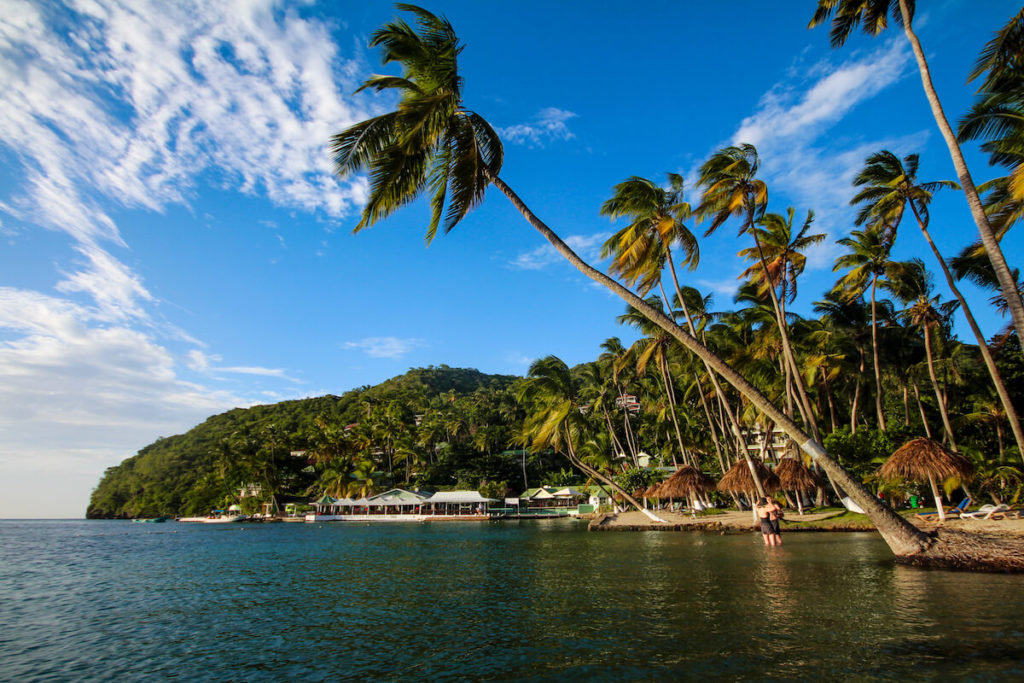
We were on the island in November before the start of the high season. Unfortunately, it rained heavily for the first four days, but then the weather got better and better. The sun shone almost every day, and it usually only rained briefly. Generally speaking, it is very warm on the island, even despite the rain. According to climate charts, temperatures average between 27 and 32 degrees Celsius year-round.
So what’s the best time to travel to Saint Lucia? The island has so far been spared from mass tourism, so you can enjoy a relaxing vacation even during peak season. However, locals recommend the months before and after peak season (November, March, April, May).
5. Currency and Finance
On the island, you pay with the Eastern Caribbean Dollar (ECD) or the US Dollar. In most restaurants and cafés, you can easily pay with a credit card. We always withdrew cash at the Scotiabank. This worked without problems at all ATMs. However, we prefer ATMs directly at the bank, which are also monitored by camera. We generally avoid ATMs on the next street corner. Attention: If you withdraw money with your credit card, fees of between €3.50 and €5 will apply.
Important: Always ask in advance what currency the prices are listed in at a restaurant, shop, or café. Sometimes it’s listed directly on the menu, but sometimes not. You’ll be happy about the low prices until you realize they’re in US dollars. €1 is currently worth just under 3 East Caribbean dollars.
6. Vaccinations & Health
The Federal Foreign Office website lists no specific vaccinations required for your trip to Saint Lucia. However, it is recommended that you check and complete your standard vaccinations (www.rki.de). Standard vaccinations for adults include tetanus, diphtheria, pertussis, mumps, measles, rubella, pneumococcus, and influenza.
Vaccinations against hepatitis A are also recommended, and for long-term stays, hepatitis B and typhoid are also recommended. Saint Lucia is malaria-free. You can find further information on this topic here: Federal Foreign Office. International health insurance is essential. You should be well covered for your travels outside the EU. Standard international health insurance is available from as little as €10 per year.
7. Accommodation on the Island
On Saint Lucia, you can find almost anything from small private rooms to luxurious villas. In general, however, the Caribbean is more expensive than other countries. You can find a few inexpensive rooms on Airbnb for €30 to €40 a night. However, if you want more comfort, you’ll have to expect to pay at least €60 to €80. If you’re looking to treat yourself, you’ll find countless great accommodations on Saint Lucia. We were lucky enough to stay in some of them.
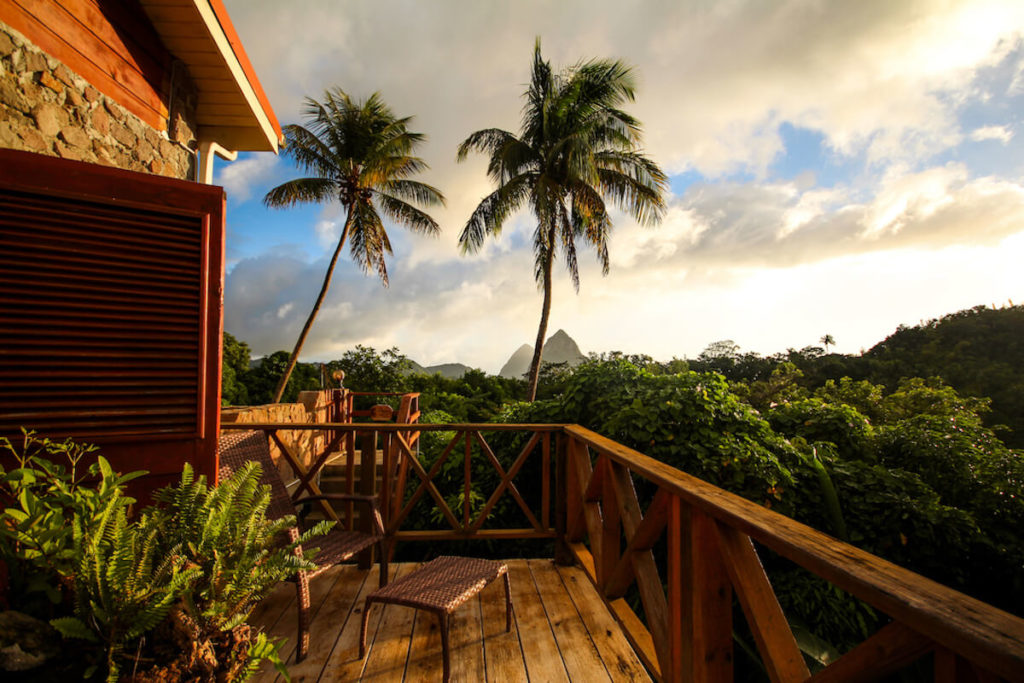
You can find a large selection of accommodations on Booking.com* or Airbnb*. Our tip: On the website www.my-stlucia.org, you’ll also find many smaller and local accommodations. There you’ll also find great information about the island, its sights, and highlights. Our beautiful accommodations are also listed on this page. We advise you to book your accommodation in advance. This saves you the hassle of searching and negotiating on site.
Our accommodations at a glance:
- Mango Sands Apartment*
- Apartment Espoir*
- Balenbouche Estate*
- Castles in Paradise*
- Crystals St. Lucia*
8. Local Transportation
The island may be small, but the distances are long and drawn out. The easiest way to get from A to B is, of course, by taxi. But taxi rides can quickly add up. As mentioned above, we paid €100 for the journey from the airport to our accommodation in Rodney Bay. You can recognize a taxi by the “TX” in its red or blue license plate.
There are no taximeters, and prices are fixed. You can also hire a taxi for several hours or days. Buses are much cheaper. The network is particularly well-developed in the north and west of the island. You can recognize the small minibuses by the sign in the windshield and the “M” in the license plate. Many different routes are offered.
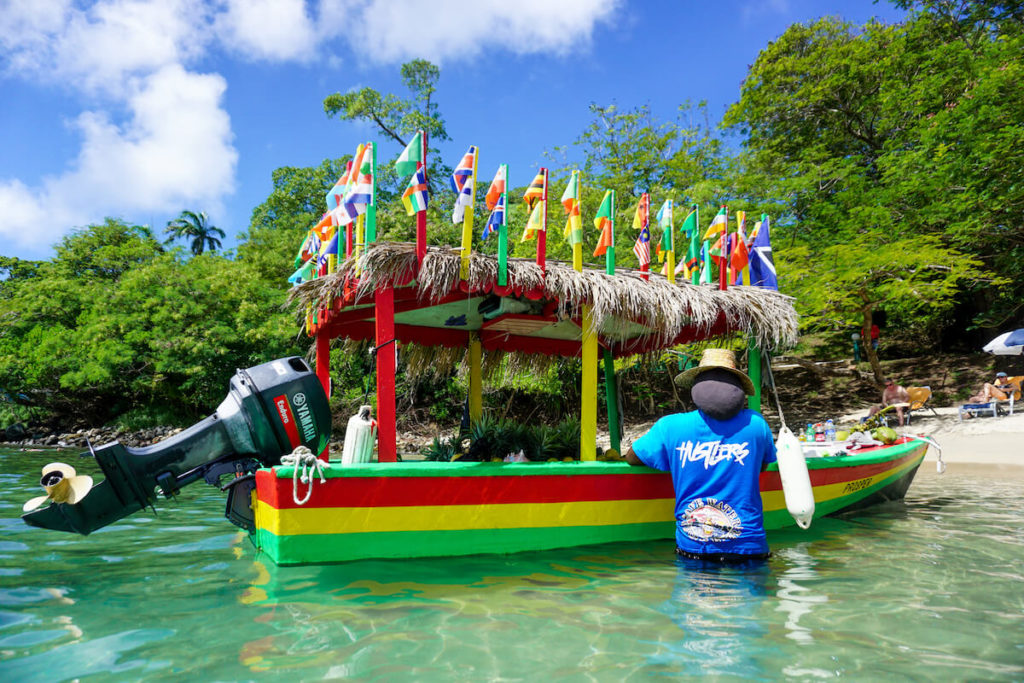
From Gros Islet to the capital, Castries, we paid just under 2 ECD (approximately €0.66). You can get from A to B quite quickly, and it’s also super cheap. Of course, the buses don’t serve every corner of the island. You can, however, signal to the driver where you want to get off. This is super practical. These minibuses are particularly easy to reach, especially in populated areas. And if you’re stuck, just ask. The locals are super friendly and helpful. They’ll be happy to explain the route and even take you to the next stop if you can’t find it.
You can also simply hail buses by raising your hand, as long as there’s still space on the bus. There isn’t a precise schedule. During the week, however, the buses run very regularly. We never had to wait very long. Of course, some routes aren’t as busy as those in the touristy north. You’ll usually find price information on a window inside the bus. However, a ride often costs only between 1 and 3 EC dollars. Of course, if you combine several buses to cover longer distances, you’ll pay a bit more.
9. Book a rental car & Driver’s License
Exploring the island on your own isn’t rocket science. However, you’ll need a rental car for that. This way, you can really reach almost every corner of the island. The two-lane roads are mostly in solid condition, but you’ll occasionally encounter deep potholes. We definitely recommend renting a small SUV. This way, you’ll be on the safe side. We’ve driven many routes that would have been a real pain without an SUV.
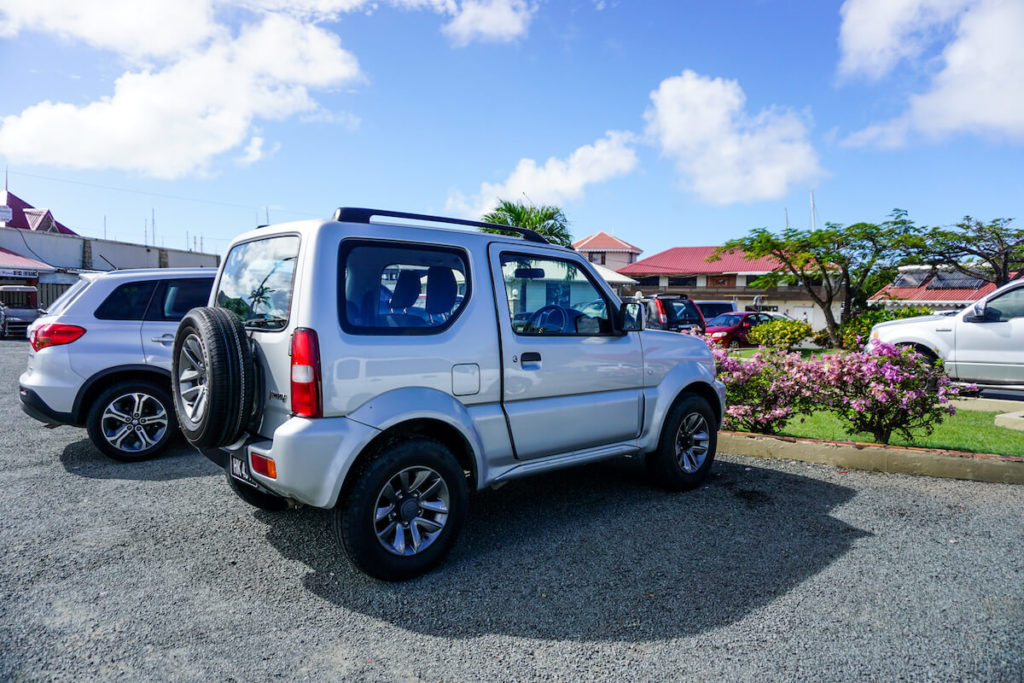
Take a look at the billiger-mietwagen.de* website. You can often find the cheapest deals here. Our SUV cost just under €70 per day for 10 days, including insurance. We had a cool Suzuki Jimny. The rental car was from Sixt. You can get a regular small car for as little as €40 per day. However, some other bloggers report that a regular small car is sufficient. We strongly advise against it. If you want to explore the island, you’ll occasionally come across some really rough gravel roads. Spare your small car this stress and instead rent an SUV designed for such surfaces.
Very important information: You must purchase a local driver’s license from the rental company. This costs a one-time fee of 54 EC dollars (approximately €18). You should always carry this license with you along with your national driver’s license. And before we forget: 1 liter of gasoline currently costs around €1 (as of May 2020). We spent a total of around €50 on gasoline for the entire trip.
10. Road Conditions & Rules
Saint Lucia has left-hand traffic, a relic from the British colonial era. Before your trip, you should practice a bit, for example, in a large parking lot. Generally, you’ll quickly get the hang of it. The roads are mostly two-lane, narrow, and sometimes winding. Always drive with foresight and extreme caution. Deep potholes are not uncommon on Saint Lucia. However, the road network is generally very well developed. You can reach all of the island’s highlights and sights by car.
There aren’t many traffic lights; mostly, everything is regulated by roundabouts (right before left). Furthermore, the same rules apply on Saint Lucia as here. You’re only allowed to drive 50 km/h within towns and 80 km/h outside towns. You should avoid Castries between 7 and 9 a.m. unless you want to be stuck in traffic. In the evening, it gets crowded again between 4 and 7 p.m.
11. Safety in Saint Lucia
How safe is a trip to Saint Lucia? We never felt uncomfortable or unsafe at any moment. Even in the minibuses or in more remote areas, there were no concerns. Saint Lucia is generally a safe island nation. Pickpockets and drugs are unfortunately found everywhere in the world. We were often offered drugs on the street. But even after a friendly “No, thank you!” we were never mistreated. We were always greeted with a friendly “God bless you” or “Have a nice day.”
So the same tips apply as almost always. You shouldn’t travel alone in remote areas after dark. You can leave valuables in your accommodation (in the safe) or at home. Never carry too much cash with you. You should save photocopies of important documents in your email inbox or Dropbox beforehand. Use ATMs in banks rather than on the nearest street corner. Never ask for help withdrawing money, and always cover the number pad when entering your PIN.
12. Budget and Costs
Saint Lucia is generally a fairly expensive destination. If you want to stay comfortably, you’ll need to budget at least €70 to €100 per night. An SUV costs around €70 per day. You can expect to spend around €30 to €40 (or more) per day on food and drink. Of course, you can also buy everything you need at the supermarket and cook for yourself. Then you can easily get by on €20 per day. Every now and then, you’ll also find small stalls selling local food. For example, we got baked goods for less than €0.50 each, and fruit for a few euros.
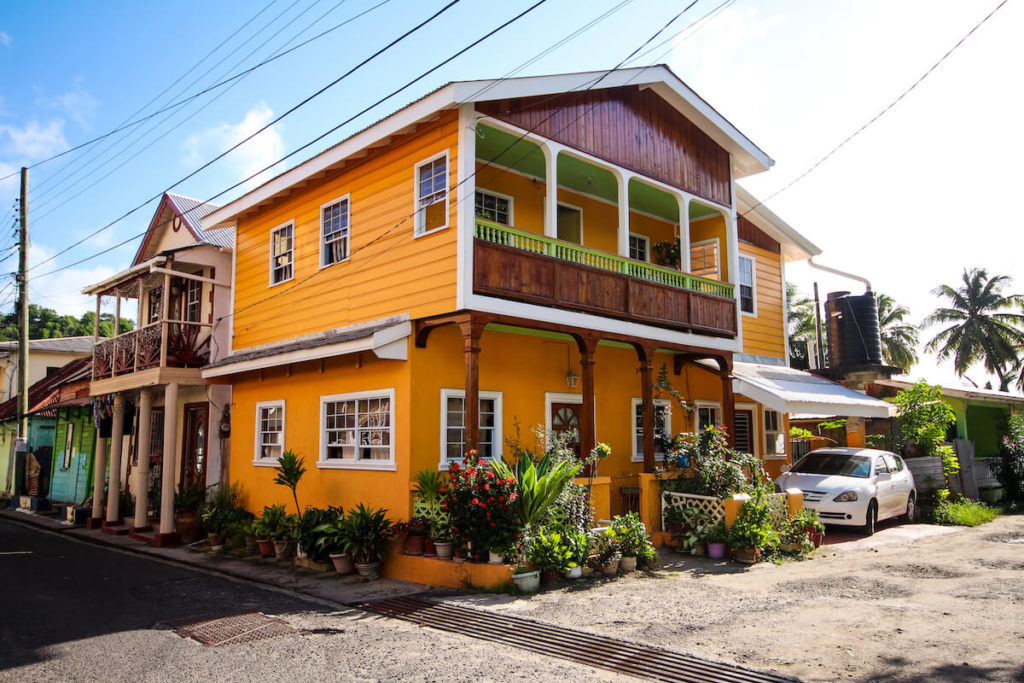
We spent most of our money in restaurants and cafes. Even in smaller fast-food restaurants, you often pay at least €7 to €10 per meal. So, if you don’t want to make too many compromises in the Caribbean, you should budget at least €100 per person per day (accommodation, food, rental car). Many excursions, hikes, and tours, on the other hand, aren’t that expensive. On Pigeon Island, for example, you only pay €9 for admission. With activities, shopping, and tours, you can easily spend €150 per person per day. But as I said, with a lot of discipline, you can also have a cheaper vacation on the island.
13. Food and Drink
On Saint Lucia, you can find virtually every fruit you can imagine. For us, it was pure paradise. Furthermore, the island boasts more than 50 local spices and the freshest ingredients. Fish and seafood, chicken, and pork are especially popular here. You’ll also find Indian, Chinese, and Italian restaurants. Some of the many resorts employ highly talented Michelin-starred chefs. Those with discerning palates will certainly find what they’re looking for here.
However, local restaurants are the best place to get to know the country’s culture. A visit to the colorful weekly markets is also recommended. Despite the island’s natural wealth, many foods still have to be imported. So don’t be surprised by the sometimes very high prices. A common specialty on Saint Lucia is saltfish and fried fish-banana balls. Red snapper, tuna, Caribbean bass, epicurean cornucopia, and vegetarian pumpkin and garlic soup are also very popular. We also brought back a bottle of banana ketchup from Saint Lucia. Be sure to try it – it’s delicious. Thanks to its fertile soil, Saint Lucia is a beautiful Garden of Eden. Mangoes, passion fruit, cashew apples, star fruit, bananas, and countless other fruits grow on every corner. We recommend a visit to one of the beautiful plantations (e.g., Pond Deoux). When it comes to drinks, you can find practically anything on the island. You should at least try the Piton Beer and a real rum punch.
You can buy water in large 5L canisters at the supermarket. Tap water is generally safe to drink. However, it sometimes tastes strongly of chlorine. If you have a sensitive stomach, you should buy bottled water at the supermarket. The island has the Massy Stores supermarket chain. There, you’ll find just about everything you need for self-catering.
14. Sights of Saint Lucia
What can you actually do in Saint Lucia? Honestly, there’s a lot. There’s something to suit every taste. Saint Lucia offers stunningly beautiful beaches, lush nature with mountains, charming Caribbean villages, a fantastic underwater world, and many cultural highlights. We particularly enjoyed the trip to Pigeon Island with its wonderful viewpoints.
You can also relax on the beach and swim in the beautiful bays. Not to be forgotten is the ascent of the Gros Pitons. The ascent and descent took four hours. A truly challenging tour. In good weather, you’ll have spectacular views of the Petit Piton, the ocean, and the hilly hinterland.
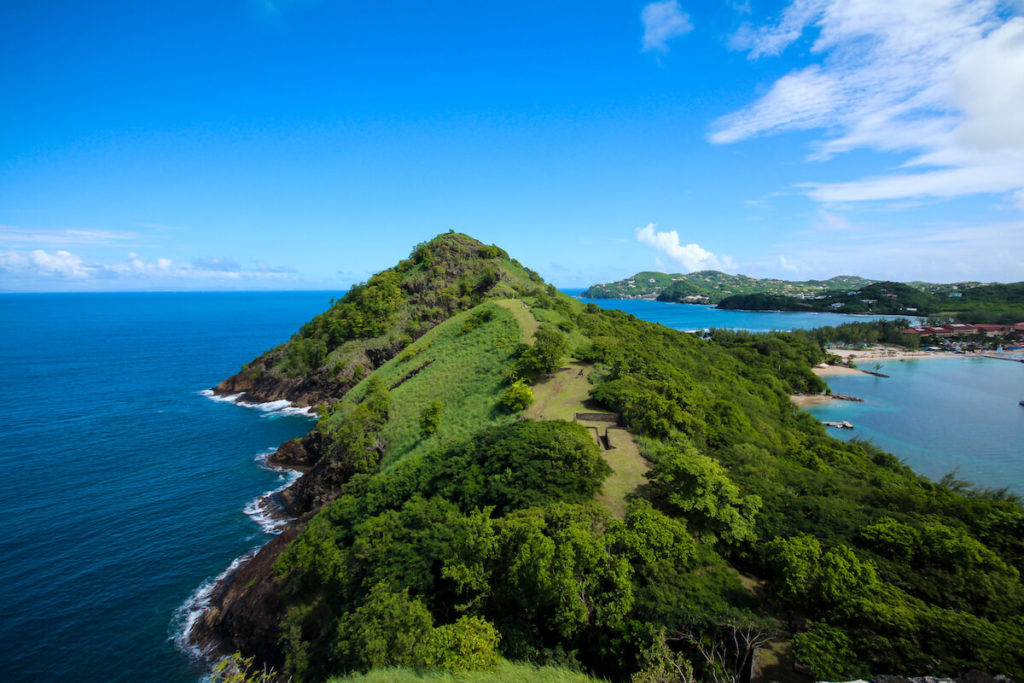
Snorkeling should not be missed, of course. Saint Lucia’s underwater world is one thing above all: COLORFUL! There are also numerous diving spots along the coast. At Anse Chastanet beach, you can rent snorkeling goggles and fins and jump right into the water. If you’d like to learn more about chocolate production, we recommend a visit to the Fond Doux Plantation. There’s also a beautiful Garden of Eden there with countless fruits and spices. There are other estates that also offer great heritage tours.
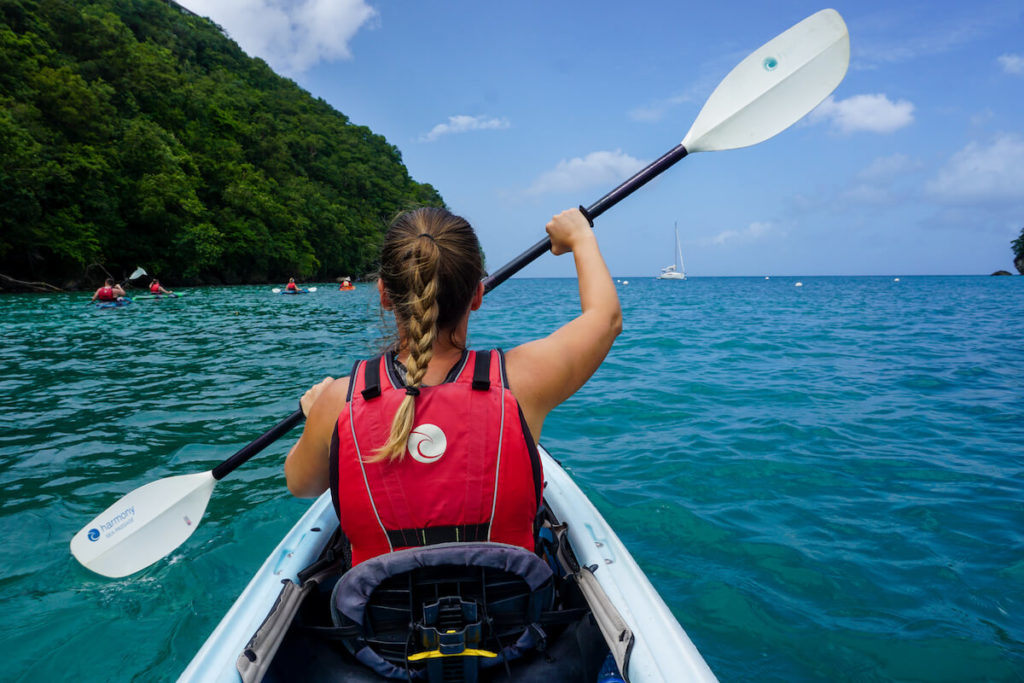
How about a kayak tour? In Marigot Bay, you can take a cool tour to the mangrove forests. We loved the trip and would book it again. One of the island’s most beautiful beaches can be found right between the two Pitons. The white Sugar Beach is located there. The scenery among the mountains is simply breathtaking.
Saint Lucia is covered in over 19,000 hectares of deep green rainforest. Here, you can enjoy wonderful hikes and walks. The Tet Paul Nature Trail, with its beautiful viewpoints, is highly recommended. But there is so much more to discover. You can learn more about this in our article: Highlights and Sights on Saint Lucia.
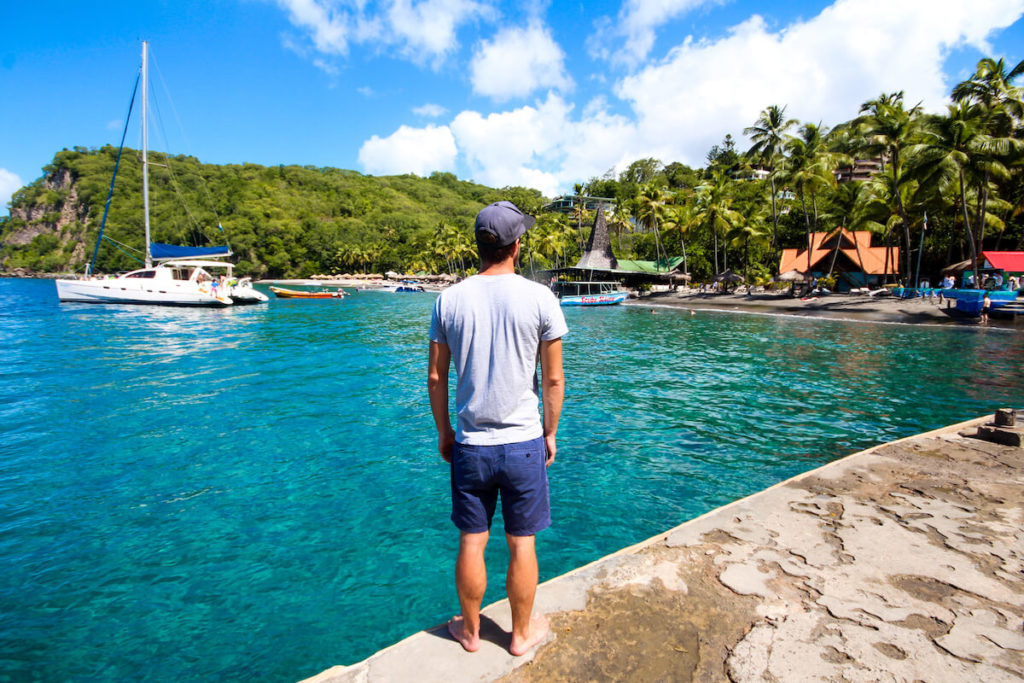
Our personal highlights at a glance
- Pigeon Island hike
- Piton climb
- Fond Doux Plantation
- Snorkeling at Anse Chastanet
- Swimming on the beach in Marigot Bay
- Kayaking tour from Marigot Bay
- Sugar Beach between the Pitons
- Tet Paul Nature Trail
- Visit Laborie
- Saturday Market in Castries
- Friday Night Jump in Gros Islet
- Des Cartier Rainforest Trail
- Visit Balenbouche Estate
15. Beaches on Saint Lucia
There are many really beautiful beaches on Saint Lucia. The good thing is that all the beaches are public. This means you can even lay down your towel on the beach in front of a 5-star resort. In the north, in Gros Islet, is the long and beautiful Reduit Beach. This beach stretches between Pigeon Island and Rodney Bay.
Pigeon Island Beach is also very popular, with its crystal-clear water and soft sand. We also found the beach in front of the Body Holiday Resort particularly beautiful. We were probably the only tourists from outside on this beach, as only hotel guests usually relax here.
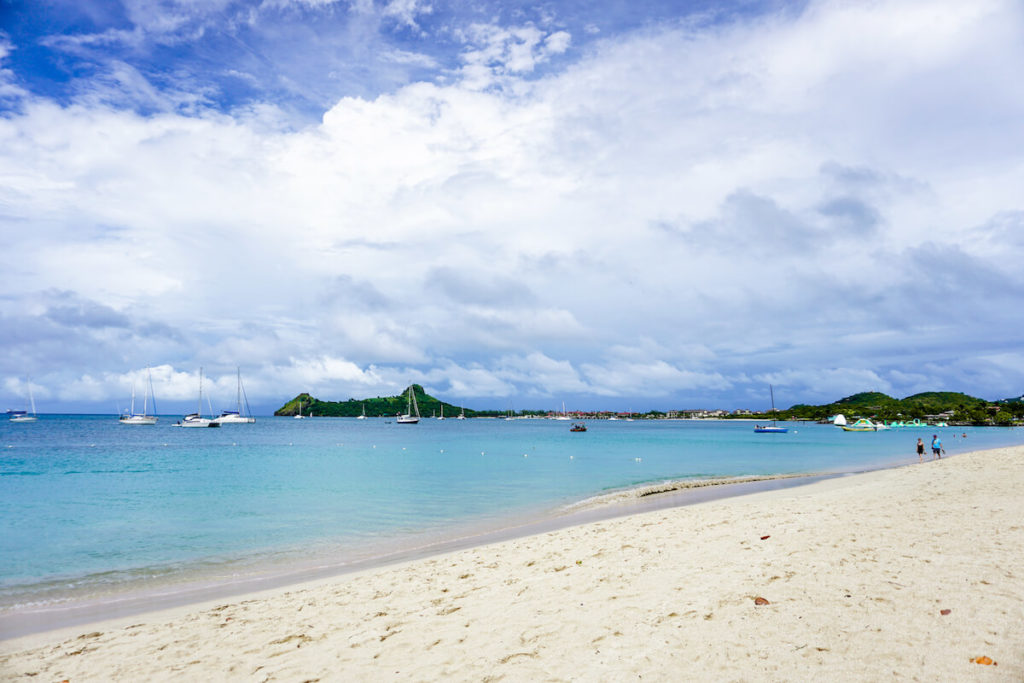
On the beach of Anse Chastanet, you can snorkel wonderfully and sip a delicious coffee in the restaurant. The drive there, however, is absolutely insane. Deep potholes make driving a real adventure. Without our SUV, we would have definitely turned around. One of the most beautiful beaches on the island is Sugar Beach, located between the two Pitons. The scenery is simply breathtaking.
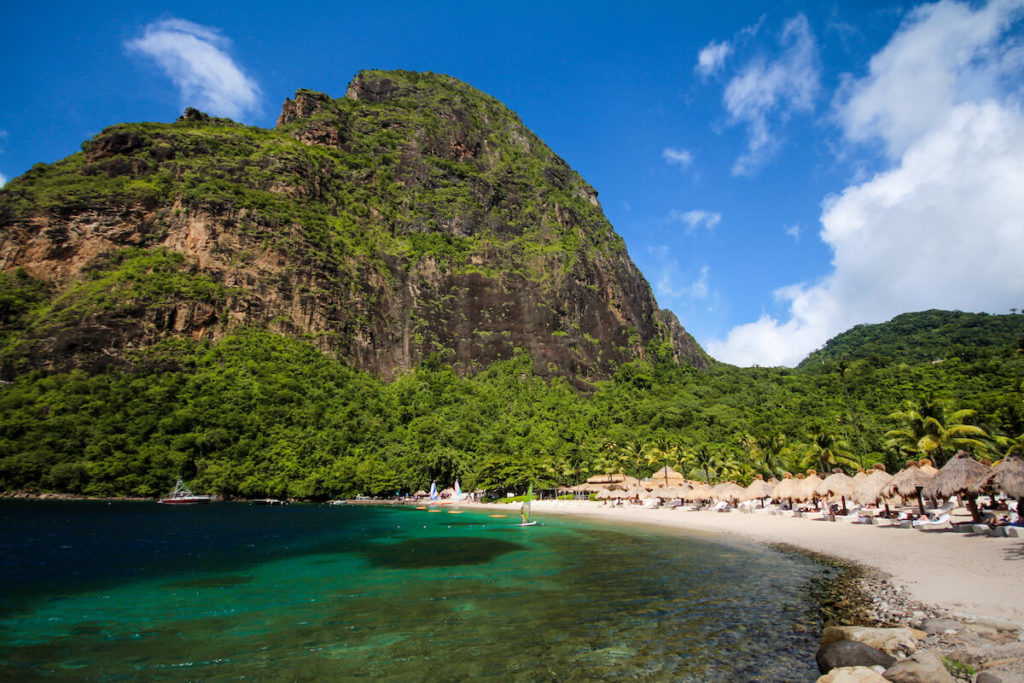
In addition to all these beaches, there are numerous others, such as the beach in Laborie, which is typically Caribbean with its many colorful houses and palm trees. On the east side, the beaches are wilder and rougher, with their waves crashing against them. A trip to Marigot Bay is also highly recommended. You can take the ferry over to the beach. Here you can spend a wonderful day relaxing.
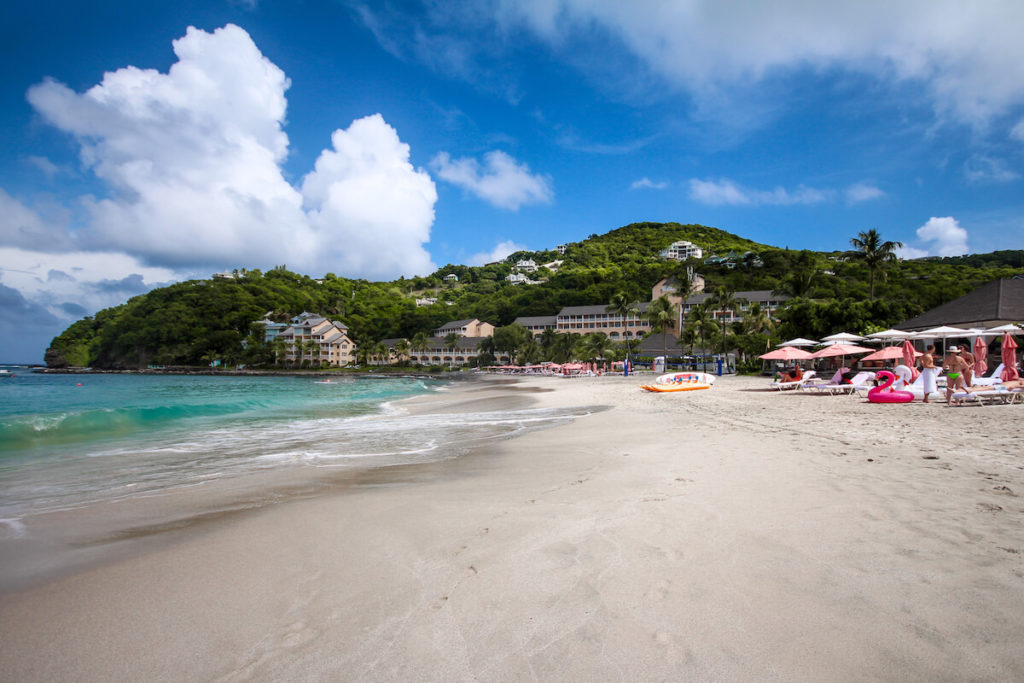
Other beaches that can be found on Google Maps: Choc Beach, Vigie Beach, Anse Cochon Beach, La Toc Beach, Cas en Bas, Anse La Raye, Anse L’Ivrogne, Roseau Beach, Coconut Bay….
16. Packing List for Your Vacation
You don’t really need a large suitcase for a Caribbean vacation. Flip-flops, swimwear, shorts, shirts, sunglasses, and the like are quickly stowed away. As always, we only packed for a week and did our laundry on-site. Very important: Don’t forget sunscreen*. Saint Lucia is very close to the equator, and the sun is very intense here. Even in the shade, you have to be prepared for sunburn. So it’s better to bring sunscreen from home; it’s always very expensive abroad.
If you have a lot of technical devices, a power strip* is a good option. This allows you to charge several devices at once. However, please remember that there are no German power strips in Saint Lucia. You will need a power adapter*. These are usually three-pin (British) or American plugs. Don’t forget sunglasses, a microfiber towel* for the beach, a daypack* for excursions, and sneakers or hiking boots for hikes and trekking tours. We travel with Osprey* backpacks. For trips to warmer climates, we usually take the 40-liter versions.
Conclusion about Saint Lucia
Saint Lucia is a true Caribbean dream. Especially for independent travelers, this island offers a great mix of relaxation, adventure, action, and culture. Many vacationers arrive by boat for just a day, while others spend their honeymoon here. We explored the island on our own for 14 days and were able to discover many facets. We recommend at least 7 days, but 10 to 14 are better.
We also definitely recommend a rental car if you want to explore the island. This gives you flexibility and allows you to change your plans spontaneously. We enjoyed the 14 days to the fullest and even fell a little in love with the island. We were particularly impressed by the nature and the friendly people. We’ve already decided that we’ll be back one day. We can wholeheartedly recommend a holiday in Saint Lucia.